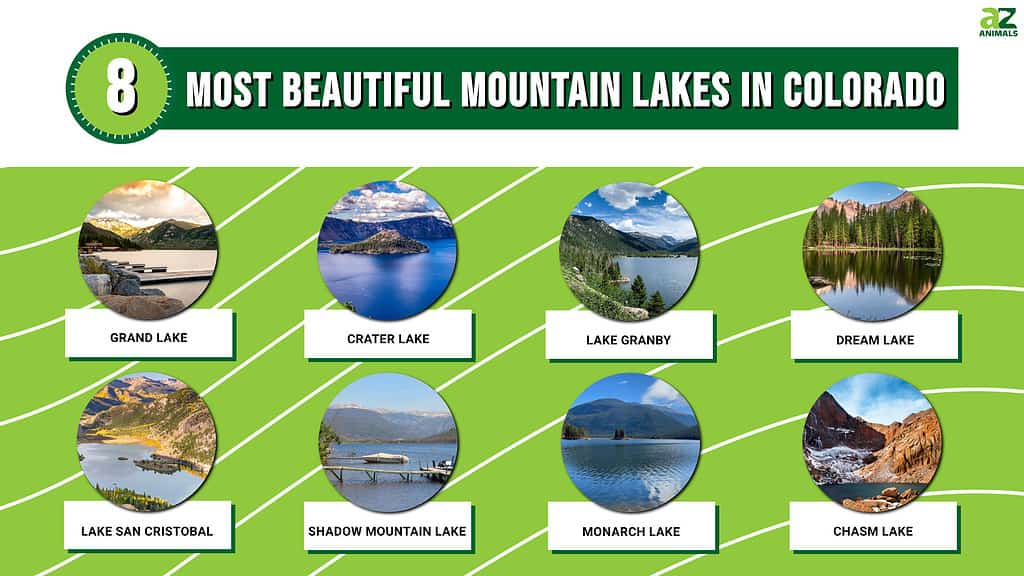
The state of Colorado has more than 4,000 bodies of water, and half of those are lakes!
Everything from massive man-made reservoirs to beautiful mountain-side retreats — if you can dream it, Colorado has it. Whether you’re a fan of the short day hike or the long trek, there are plenty of accessible lakes, from jet skiing and ice-fishing to camping and sailing.
Read on to discover 8 of the most beautiful mountain lakes in Colorado!
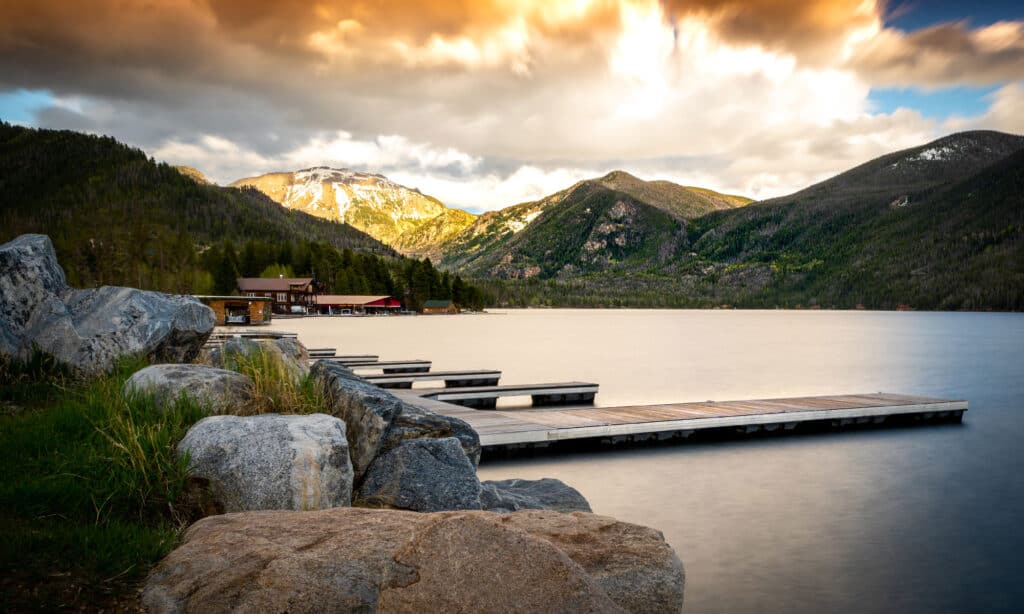
Grand Lake is the largest and deepest lake in Colorado.
©Markel Echaburu Bilbao/Shutterstock.com
Grand Lake
Grand Lake is the largest natural body of water in Colorado. It’s one of the 1,500 publicly owned lakes in the state. With a maximum depth of 389 feet, Grand Lake is also the deepest lake in Colorado. Nestled next to the Rocky Mountain National Park in the town of Grand Lake, it provides immediate access to the headwaters of the Colorado River.
The north shore of the town of Grand Lake is the perfect spot to access the lake by boat. You can even enjoy a stroll on its famous boardwalk, originally constructed in the late 1800s. Estes Park is also a short drive away, accessible via Trail Ridge Road. At 12,183 feet, it holds the record for the highest elevation of a man-made road in the United States.
Grand Lake is a part of the Colorado-Big Thompson bill of 1937. It connects it to Shadow Mountain Lake (a reservoir built in 1947) and Lake Granby (a reservoir built in 1950). All of these bodies of water are separated by large man-made gates that re-direct water flow if needed. Water from all three lakes is used by various municipalities for their agricultural and industrial needs. They also create hydroelectric power for five different power stations east of Colorado’s Rocky Mountains.
Grand Lake itself sits at 8,369 feet, and a quick visit to the Grand Lake Marina should provide you with anything you need for a beautiful day on the water. Paddleboards, water skis, wakeboards, kayaks, and sailboats abound, and fishing is also popular. Grand Lake is also home to the highest-altitude yacht club in the world, founded in the spring of 1902. The Ute Tribe originally called Grand Lake by the name of Spirit Lake. They believed their ancestors’ souls were kept frozen in the waters.
Activities
Wintertime only brings more recreational opportunities, as Grand Lake has many trails for skiing, snowboarding, and snowmobiling. The Grand Lake Nordic Center can help coordinate equipment rentals and sleigh rides through the town.
The Rocky Mountain National Park and the Arapaho National Forest/Recreation Area are common tourist destinations. Grand Lake is a must-see for anyone visiting Colorado. Be sure to budget a few days as there’ll be plenty to do!
Crater Lake
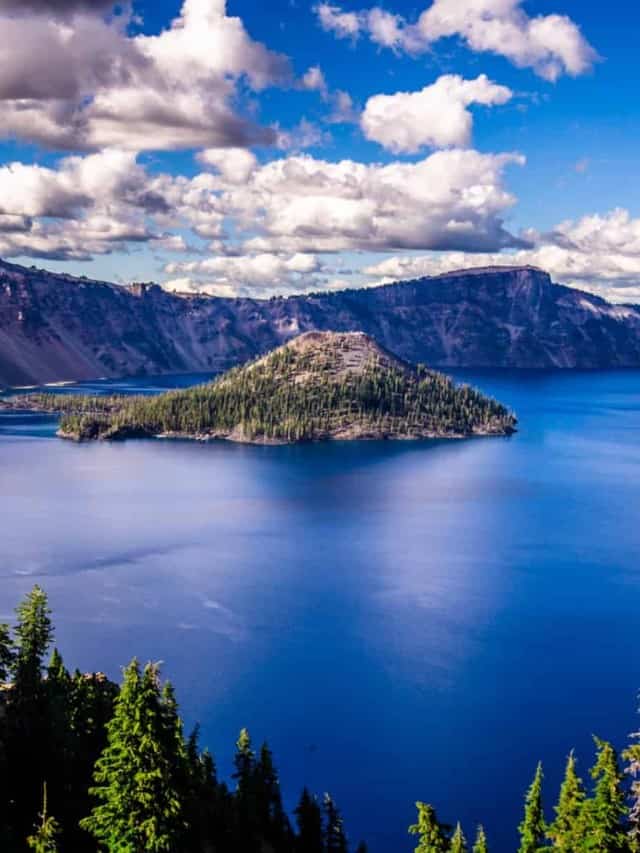
Crater Lake sits at an elevation of 10,075 feet.
©Pung/Shutterstock.com
Crater Lake is located in the Rocky Mountains of Colorado, in the Maroon Bells Snowmass Wilderness just southeast of Aspen. It is accessible after a short two-mile hike along the Maroon Lake Trail through the White River National Forest.
The trail sits at an elevation of 10,075 feet and lasts about 500 feet. Once completed, hikers will be greeted with the welcome sight of crystal-clear lake water nestled amongst the majestic 14,000-foot high terrain of the Rocky Mountains and the Elk Mountains. Three features of the Elk Mountain range draw tourists year in and year out: the Sleeping Sexton, Pyramid Peak, and the twin peaks of the Maroon Bells.
The Maroon Bells are particularly famous for supposedly inspiring Fleetwood Mac’s 1975 hit “Landslide,” written after Stevie Nicks vacationed in Colorado. Nicks remembers gazing out across the mountain range when she “realized then that everything could tumble, and when you’re in Colorado, and you’re surrounded by these incredible mountains, you think avalanche. It meant the whole world could tumble around us, and the landslide would bring you down.”
Activities
Crater Lake itself dries up annually by October, so be sure to visit early during the year to catch it at its full size. Crater Lake’s location a few miles from the road also makes it a popular destination for snowshoeing, skiing, and hiking. Backpacking is also a common recreational activity, and free camping at designated sites is provided by the US Forest Service.
For those looking for a longer hiking trek, Four Pass Loop is a highly recommended trail that takes a few days to complete. Fishers enjoy Crater Lake for its supply of trout, and local wildlife includes deer, bears, foxes, moose, marmots, and elk.
Another popular trail is the Maroon-Snowmass Trail, which takes you between Maroon Lake and Crater Lake. This trek is busy at dawn when you can watch the sunrise light up the morning sky from the shoreline of Maroon Lake.
Lake Granby
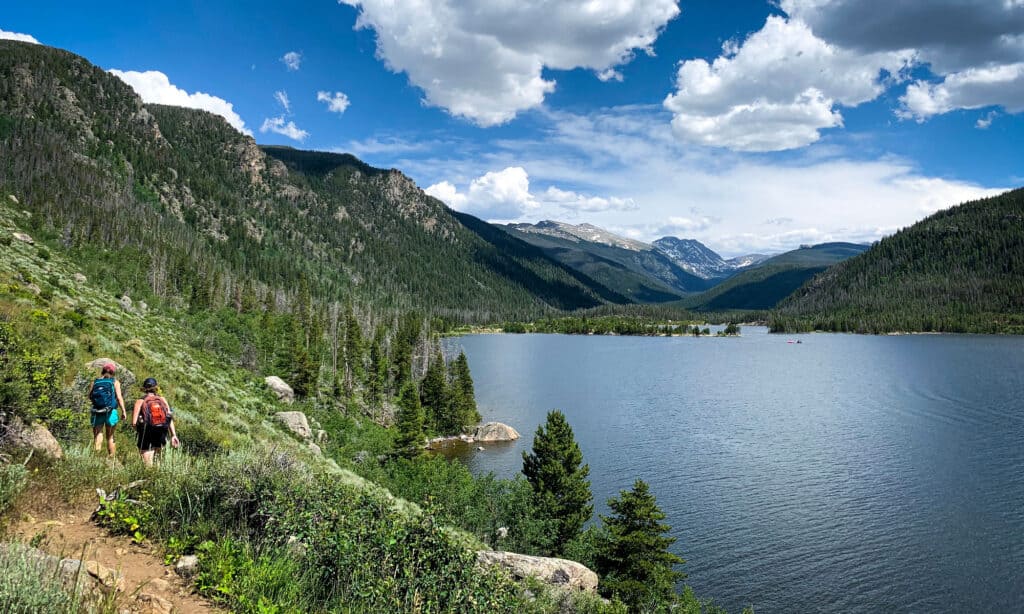
Lake Granby is known to have the most Mackinaw of any lake in Colorado, drawing out anglers hoping to hook a giant one!
©mredd/Shutterstock.com
Located a mere 5 miles away from the city of Granby, Lake Granby is a tributary of the Colorado River and is also connected to Grand Lake via a series of gates. Lake Granby is a 221-foot-deep man-made body of water completed in 1950 alongside the construction of the Granby Dam. It is the third-largest lake in Colorado. With its 40 miles of shoreline, Lake Granby is recognized as one of the best bodies of water for fishing.
Common fish found at Lake Granby include several species of salmon (such as Kokanee Salmon), Splake, Largemouth Bass, Mackinaw, Brown Trout, and Rainbow Trout. Lake access is easy and quick, thanks to its three docks and the lake’s Yacht Club. Lake Granby is also the location for the famous 3 Lakes Ice Fishing Contest, the biggest tournament of its kind west of the Mississippi River. Much of the water in Lake Granby comes from the Farr Pump plant, which is connected to the nearby Shadow Mountain Reservoir.
In addition to excellent fishing, this lake is home to 260 campgrounds and is a fantastic option for boating, kayaking, and canoeing as well. As the third-largest lake in Colorado, Lake Granby offers much in the way of recreation for any curious visitors. Its proximity to Grand Lake, Shadow Mountain Lake, and the Colorado River makes it a must-see when you’re in the state of Colorado.
Dream Lake
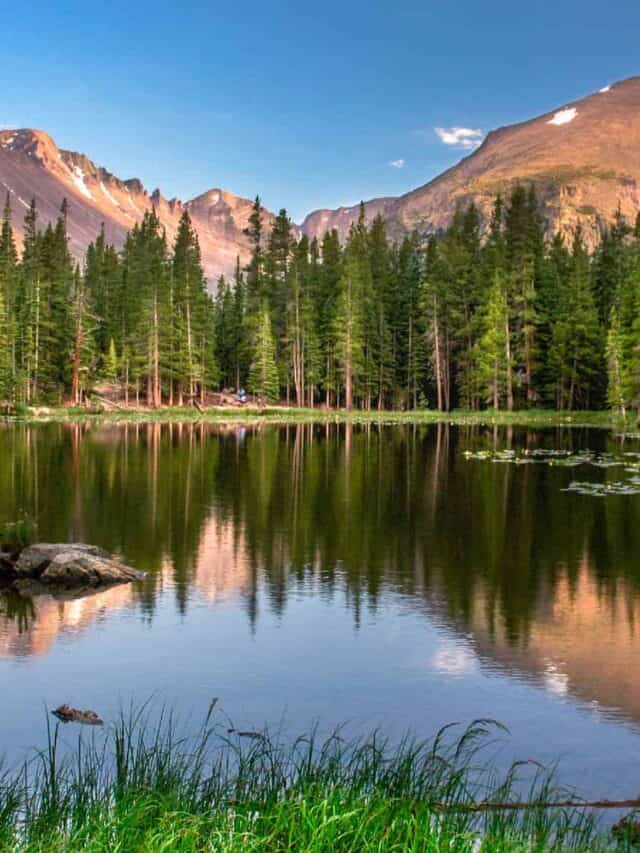
Dream Lake presents the perfect opportunity for hikers looking to find a beautiful alpine lake to enjoy a picnic.
©iStock.com/Gerald Zaffuts
With a name like Dream Lake, it’s not hard to find yourself drawn to this scenic location. It is accessible after a short 2-mile hike among the Rocky Mountains. The trail that leads to Dream Lake is one of the most sought-after hikes in the Rocky Mountain National Park.
Along the path to Dream Lake, you’ll be lucky enough to pass by two additional lakes as well. The hike starts at Bear Lake and winds its way through Nymph Lake before depositing you at the base of Hallett Peak. The alpine cliff sides of the Rock Mountains and the crystal clear lake water make for a potent combination, and whether you’re hiking in the summer or snowshoeing in the winter, you’ll be glad you came.
Dream Lake is relatively small and so remote that no one has properly mapped its surface area or maximum depth. We do know it rests at an elevation of 9,902 feet, but with views like the one it provides, you won’t find yourself worrying over the lack of geographical details for too long.
Lake San Cristobal

Lake San Cristobal is a naturally occurring lake that was first shaped over 700 years ago.
©Paul Brady Photography/Shutterstock.com
Lake San Cristobal is a two-mile-long lake at an elevation of 9,003 feet in the San Juan Mountains. It is a freshwater lake, popular for its fishing, boating, and camping opportunities, and the second-largest natural lake in the state of Colorado.
Lake San Cristobal is a naturally occurring lake that was first shaped over 700 years ago during the Slumgullion Earthflow landslide. This sudden movement formed a dam across the Gunnison River, where it intersects with Lake Fork.
Due to the lake’s considerable age and less than intentional formation, the United States Geological Survey had to scrutinize the condition of the area to determine whether or not the dam could be predicted to break.
After a full investigation, they determined it was solid and unlikely to pose a problem in the future. Evidence suggests that it would take 2,500 years for the lake to fill with sediment that has been slowly leaking in from Slumgullion Creek and Lake Fork.
Lake San Cristobal gets its name from the Spanish “Saint Christopher.” Many abandoned silver mines have been found in the area, making it a common destination for sightseeing. The lake itself is a popular site for biking, fishing, mountain climbing, hiking, four-wheeling, and camping. Many people enjoy motorboats, kayaks, and canoe rides on the water as well. Wildlife found in the area includes elk, moose, beavers, and several species of migratory birds, including Canadian geese and ducks.
Shadow Mountain Lake

Shadow Mountain Lake is known for providing a full-service lake experience for non-anglers.
©Greens and Blues/Shutterstock.com
Shadow Mountain Lake, nestled among the peaks of the Rocky Mountains, is a beautiful man-made reservoir. It often draws additional visitors from nearby Lake Granby and Grand Lake, to which it is connected. It has a surface area of 1,346 acres and a maximum depth of 24 feet. The lake is well-loved for its boating options, including sailing, canoeing, kayaking, power boating, and jet skiing.
The Green Ridge Campground is available for those looking to stay the night and has two docks for launching boats. With 8 miles of shoreline, many anglers flock to this lake for its Kokanee Salmon, Rainbow Trout, Mackinaw, Brown Trout, Cutthroat Trout, and scenic fly-fishing.
The Rocky Mountain National Park is located just east of Shadow Mountain Lake. You can easily spend a day in this 10,000-foot elevation mountain range. Hiking, picnicking, horseback riding, and bird watching are other popular outdoor activities at the lake. You can also camp at one of its 75 campgrounds.
Monarch Lake
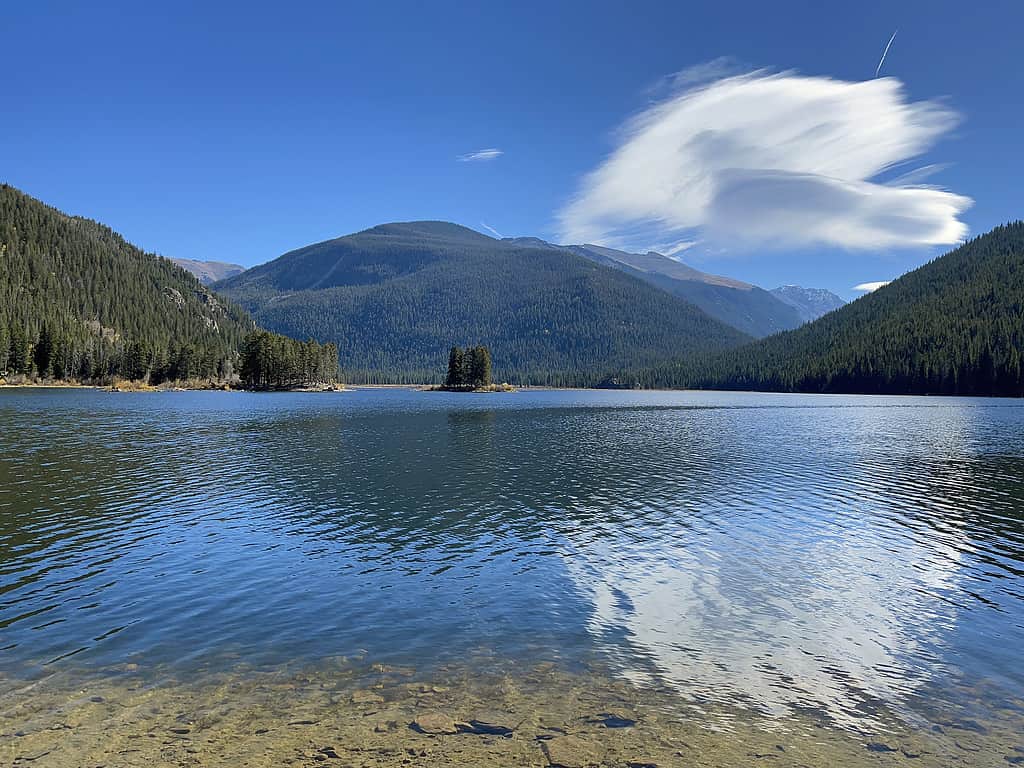
Counted as one of the six “Great Lakes of Colorado”, Monarch Lake is a man-made reservoir.
©Jeffrey Beall, CC BY 4.0 <https://creativecommons.org/licenses/by/4.0>, via Wikimedia Commons – License
Monarch Lake is a man-made reservoir in the Arapaho National Forest, next to the Rocky Mountain National Park. It is counted as one of the six “Great Lakes of Colorado,” in addition to Willow Creek Reservoir, Meadow Creek Reservoir, Shadow Mountain Lake, Grand Lake, and Lake Granby. It is the only lake of the six that stays full annually, as most of the water supplied to the surrounding area comes from the other reservoirs. Monarch Lake was constructed in the early 1900s. It was built with a dam and hydroelectric power plant to help supply drinking water to adjacent towns.
While camping is allowed nearby, there are no camping sites at Monarch Lake. In addition, there are no swimmable shorelines or motorized boats allowed on the water. What draws visitors to this 140-acre lake is the abundance of available hiking trails in the area.
The four-mile-long Monarch Lake Loop trail that circles around the lake are an easy-going scenic route. This trail appeals to most casual hikers and those just looking for a leisurely walk. Many of the trails will take you to some of Colorado’s most famous hiking spots. On the west side of the Monarch Lake trail, you can begin down a path that is part of the Continental Divide National Scenic Trail, which leads from Canada all the way down to Mexico.
Other parts of the main lake trail lead to the popular Indian Peaks Wilderness Area. Some even lead to the Rocky Mountain National Park.
Activities
In addition to the excellent hiking, sailboating and fishing are popular activities at Monarch Lake. Common species include Brown Trout, Lake Trout, Cutthroat Trout, Rainbow Trout, Brook Trout, Sucker, and Arctic Grayling. With a maximum depth of 8 feet, the shallow, clear waters of Monarch Lake make for an exciting fishing experience. A lack of motorized boats helps keep the water clear. You can fish from a canoe or kayak just as easily as you could from the shoreline.
Birdwatchers have plenty of opportunities to observe geese, woodpeckers, osprey, hummingbirds, and many other types of waterfowl. Other wildlife seen at Monarch Lake includes deer, black bears, and moose.
Cross-country skiing and snowshoeing are popular wintertime sports when the weather turns cold. There are plenty of lodges, ranches, bed-and-breakfasts, motels, and ranches nearby, so travelers in the area won’t want long for comfort and shelter.
Chasm Lake
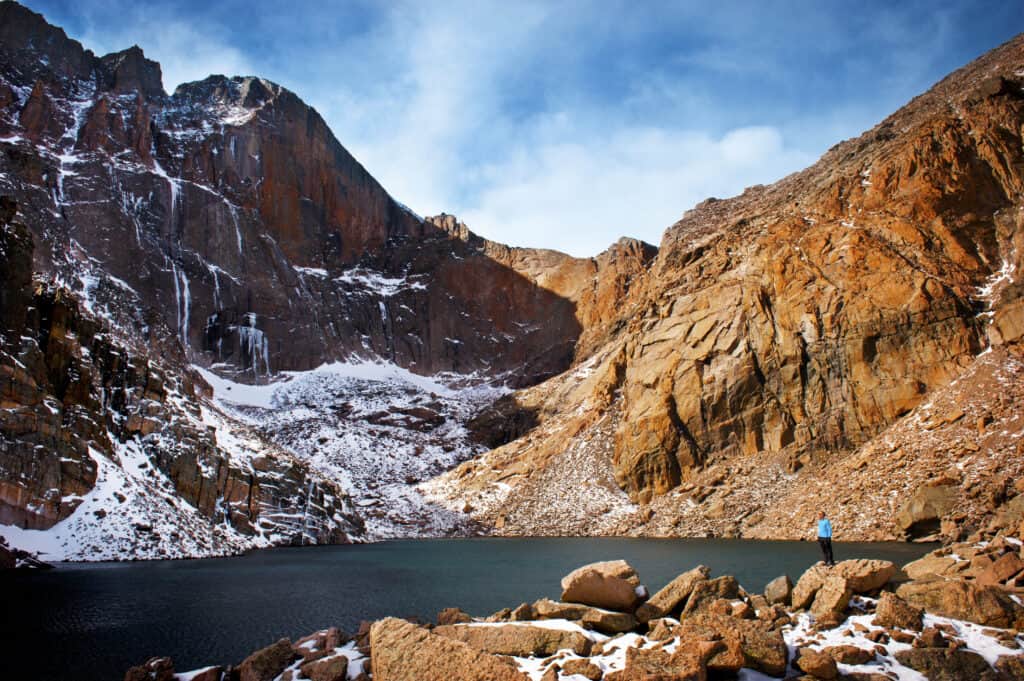
Chasm Lake is a beautiful alpine lake with outstanding panoramic views.
©iStock.com/shaferaphoto
Chasm Lake is a glacial lake located beneath the eastern slope of Longs Peak, a 14,259-foot-long mountain face in the Rocky Mountain National Park. This lake is part of a glacial cirque, a bowl-shaped geological depression that sometimes forms on the side of mountains, sometimes turning into a valley if it erodes deep enough.
This glacial cirque is particularly scenic, with granite walls, talus fields (slopes made of loose rock), and the Mills Glacier being specific attractions. Photography is a common activity when visiting Chasm Lake for this reason. Columbine Falls is another beautiful sight to catch, as its waters fall right over the cliffside.
The lake is accessible via a four-and-a-half mile hike right off of Colorado Highway 7, just south of Estes Park. By following the East Longs Peak Trail through to the Chasm Lake Trail, you should find yourself at the lake within four to six hours.
The views from Chasm Lake do not disappoint: Mount Lady Washington to the north, Long Peaks to the west, and Mount Meeker to the south mean you will be surrounded by towering nature in all its beauty. In addition to the scenery, many of the United States’ best rock climbs are nearby, including D-7, The Casual Route, The Diamond, and Pervertical Sanctuary. Other nationally renowned climbs include Stettner’s Ledges and Keiner’s Ledges, The Diagonal, and Kor’s Door.
Animals That Live in Colorado
The native wildlife in Colorado is as diverse as its ecosystems. Around 750 invertebrate species can be found in the state, including bison, bighorn sheep, elk, moose, mountain lions, bears, and foxes.
Prairie dogs play an essential role in Colorado’s ecosystems due to the tunnels they dig that are used by about 150 different animal species.
The Rocky Mountain bighorn sheep, which has been reduced to endangered status, was declared the official state animal in 1961. The state bird is the lark bunting, which can be widely seen throughout Colorado from April until September.
For a complete guide to Colorado’s native animals, including where to find the top wild animals, go here.
Summary of the 8 Most Beautiful Mountain Lakes in Colorado
| Rank | Lake |
|---|---|
| 1 | Grand Lake |
| 2 | Crater Lake |
| 3 | Lake Granby |
| 4 | Dream Lake |
| 5 | Lake San Cristobal |
| 6 | Shadow Mountain Lake |
| 7 | Monarch Lake |
| 8 | Chasm Lake |
The photo featured at the top of this post is © Markel Echaburu Bilbao/Shutterstock.com
Thank you for reading! Have some feedback for us? Contact the AZ Animals editorial team.






